Impact of Training and Development on Employee Motivation Analysis
VerifiedAdded on 2024/05/31
|50
|12856
|431
Report
AI Summary
This report investigates the impact of training and development on employee motivation and performance within the UK retail industry, focusing on John Lewis. The study employs a quantitative approach, utilizing questionnaire surveys distributed to 254 employees, with 188 responses analyzed using SPSS. The research aims to understand the significance of training programs in enhancing employee skills, bridging performance gaps, and fostering a positive work approach. Key research questions explore the influence of HR training, individual gains from training, performance assessment, and motivational impact. The findings suggest a strong correlation between training programs and improved employee performance, highlighting the importance of continuous learning and skill development in the retail sector. The report concludes with recommendations for optimizing training initiatives and addressing limitations for future research, emphasizing the value of training in boosting employee competence and overall organizational success. Desklib provides access to similar solved assignments and research papers for students.

IMPACT OF TRAINING AND DEVELOPMENT ON
EMPLOYEE MOTIVATION
EMPLOYEE MOTIVATION
Paraphrase This Document
Need a fresh take? Get an instant paraphrase of this document with our AI Paraphraser
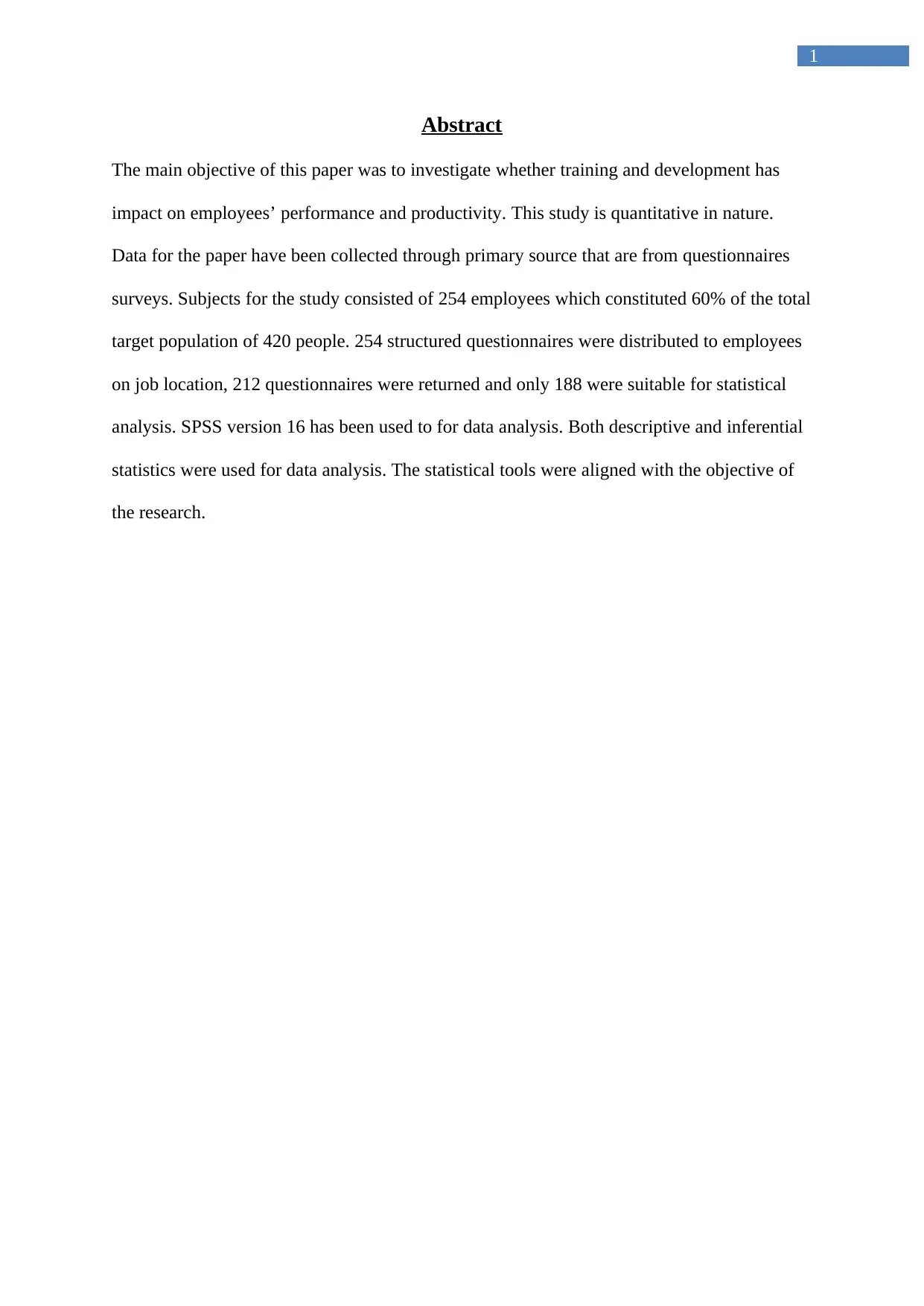
1
Abstract
The main objective of this paper was to investigate whether training and development has
impact on employees’ performance and productivity. This study is quantitative in nature.
Data for the paper have been collected through primary source that are from questionnaires
surveys. Subjects for the study consisted of 254 employees which constituted 60% of the total
target population of 420 people. 254 structured questionnaires were distributed to employees
on job location, 212 questionnaires were returned and only 188 were suitable for statistical
analysis. SPSS version 16 has been used to for data analysis. Both descriptive and inferential
statistics were used for data analysis. The statistical tools were aligned with the objective of
the research.
Abstract
The main objective of this paper was to investigate whether training and development has
impact on employees’ performance and productivity. This study is quantitative in nature.
Data for the paper have been collected through primary source that are from questionnaires
surveys. Subjects for the study consisted of 254 employees which constituted 60% of the total
target population of 420 people. 254 structured questionnaires were distributed to employees
on job location, 212 questionnaires were returned and only 188 were suitable for statistical
analysis. SPSS version 16 has been used to for data analysis. Both descriptive and inferential
statistics were used for data analysis. The statistical tools were aligned with the objective of
the research.

2
Table of Contents
Chapter 1: Introduction..............................................................................................................5
Background of Study..............................................................................................................5
Background of the Company.................................................................................................5
Rationale of the study.............................................................................................................5
Problem statement..................................................................................................................6
Research Aims.......................................................................................................................6
Research Objectives...............................................................................................................7
Research Questions................................................................................................................7
Research Hypothesis..............................................................................................................8
Significance of the study........................................................................................................9
Structure of the research study...............................................................................................9
Conclusion:..........................................................................................................................10
Chapter 2: Literature Review...................................................................................................12
Chapter 3: Research Methodology...........................................................................................18
Introduction..........................................................................................................................18
Research method outline......................................................................................................18
Research Onion....................................................................................................................19
Research Philosophy............................................................................................................19
Research Approach..............................................................................................................20
Research Design...................................................................................................................21
Table of Contents
Chapter 1: Introduction..............................................................................................................5
Background of Study..............................................................................................................5
Background of the Company.................................................................................................5
Rationale of the study.............................................................................................................5
Problem statement..................................................................................................................6
Research Aims.......................................................................................................................6
Research Objectives...............................................................................................................7
Research Questions................................................................................................................7
Research Hypothesis..............................................................................................................8
Significance of the study........................................................................................................9
Structure of the research study...............................................................................................9
Conclusion:..........................................................................................................................10
Chapter 2: Literature Review...................................................................................................12
Chapter 3: Research Methodology...........................................................................................18
Introduction..........................................................................................................................18
Research method outline......................................................................................................18
Research Onion....................................................................................................................19
Research Philosophy............................................................................................................19
Research Approach..............................................................................................................20
Research Design...................................................................................................................21
⊘ This is a preview!⊘
Do you want full access?
Subscribe today to unlock all pages.

Trusted by 1+ million students worldwide
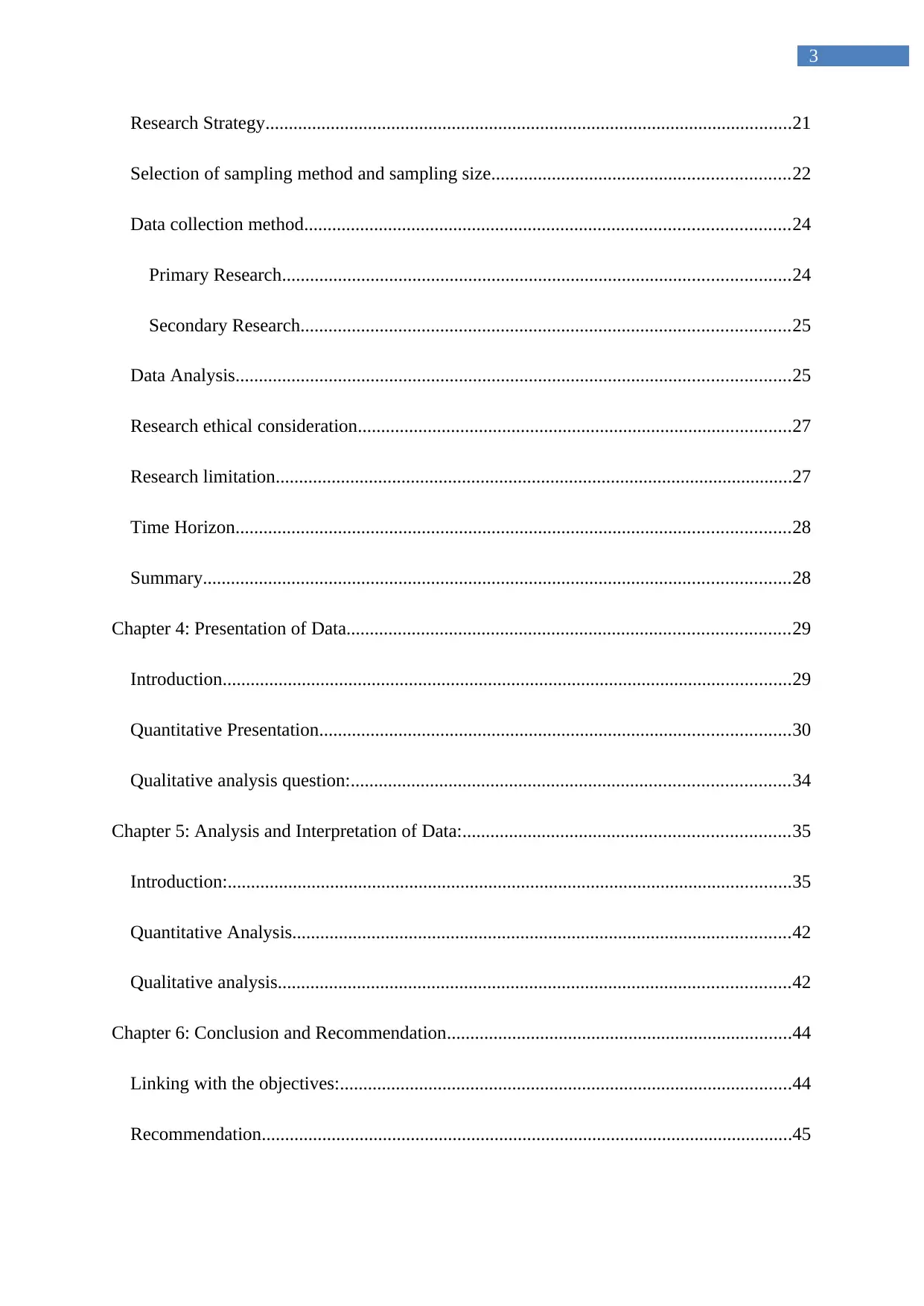
3
Research Strategy.................................................................................................................21
Selection of sampling method and sampling size................................................................22
Data collection method........................................................................................................24
Primary Research.............................................................................................................24
Secondary Research.........................................................................................................25
Data Analysis.......................................................................................................................25
Research ethical consideration.............................................................................................27
Research limitation...............................................................................................................27
Time Horizon.......................................................................................................................28
Summary..............................................................................................................................28
Chapter 4: Presentation of Data...............................................................................................29
Introduction..........................................................................................................................29
Quantitative Presentation.....................................................................................................30
Qualitative analysis question:..............................................................................................34
Chapter 5: Analysis and Interpretation of Data:......................................................................35
Introduction:.........................................................................................................................35
Quantitative Analysis...........................................................................................................42
Qualitative analysis..............................................................................................................42
Chapter 6: Conclusion and Recommendation..........................................................................44
Linking with the objectives:.................................................................................................44
Recommendation..................................................................................................................45
Research Strategy.................................................................................................................21
Selection of sampling method and sampling size................................................................22
Data collection method........................................................................................................24
Primary Research.............................................................................................................24
Secondary Research.........................................................................................................25
Data Analysis.......................................................................................................................25
Research ethical consideration.............................................................................................27
Research limitation...............................................................................................................27
Time Horizon.......................................................................................................................28
Summary..............................................................................................................................28
Chapter 4: Presentation of Data...............................................................................................29
Introduction..........................................................................................................................29
Quantitative Presentation.....................................................................................................30
Qualitative analysis question:..............................................................................................34
Chapter 5: Analysis and Interpretation of Data:......................................................................35
Introduction:.........................................................................................................................35
Quantitative Analysis...........................................................................................................42
Qualitative analysis..............................................................................................................42
Chapter 6: Conclusion and Recommendation..........................................................................44
Linking with the objectives:.................................................................................................44
Recommendation..................................................................................................................45
Paraphrase This Document
Need a fresh take? Get an instant paraphrase of this document with our AI Paraphraser

4
Limitation.............................................................................................................................46
Future Scope of the Study....................................................................................................47
References................................................................................................................................49
Limitation.............................................................................................................................46
Future Scope of the Study....................................................................................................47
References................................................................................................................................49
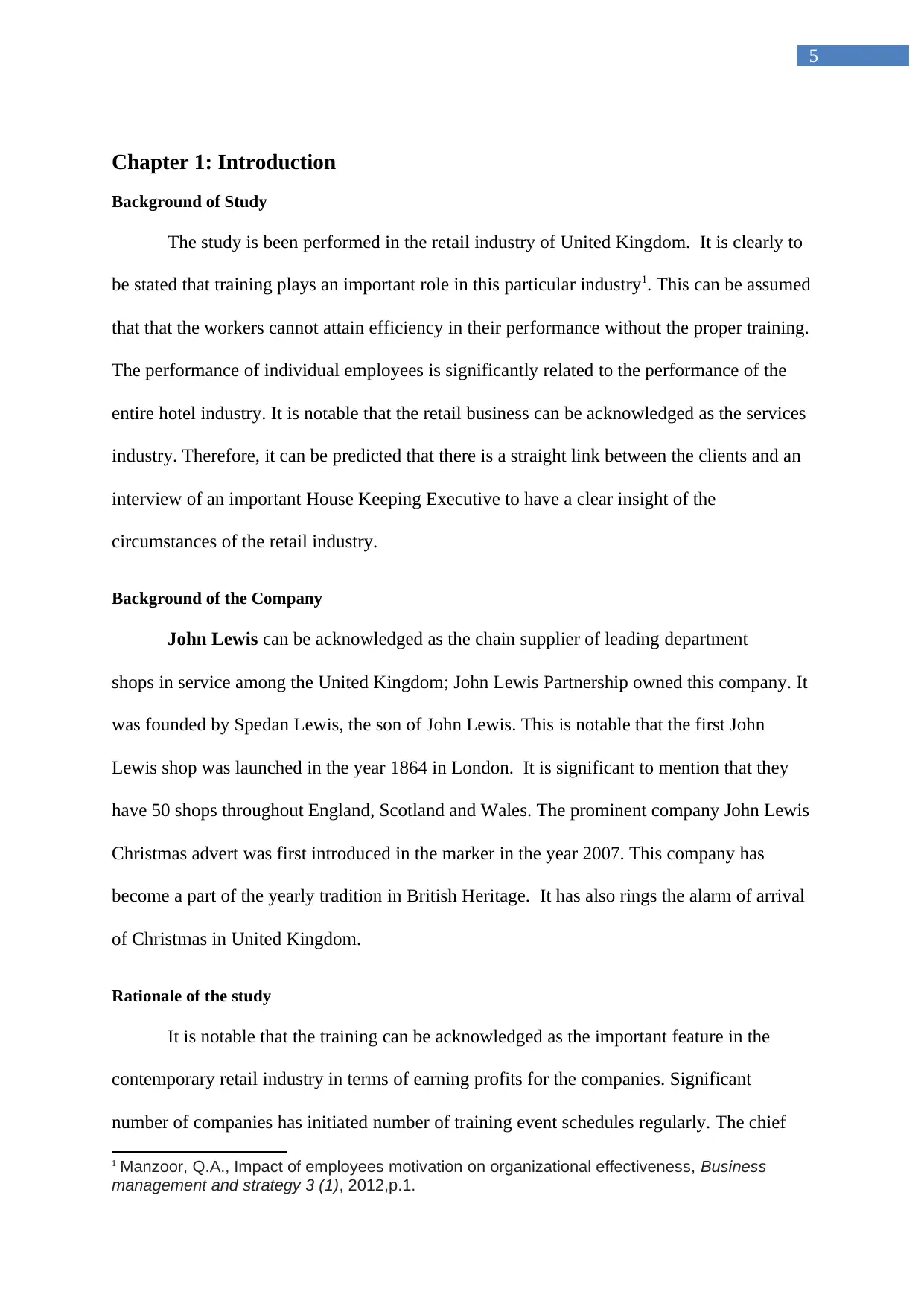
5
Chapter 1: Introduction
Background of Study
The study is been performed in the retail industry of United Kingdom. It is clearly to
be stated that training plays an important role in this particular industry1. This can be assumed
that that the workers cannot attain efficiency in their performance without the proper training.
The performance of individual employees is significantly related to the performance of the
entire hotel industry. It is notable that the retail business can be acknowledged as the services
industry. Therefore, it can be predicted that there is a straight link between the clients and an
interview of an important House Keeping Executive to have a clear insight of the
circumstances of the retail industry.
Background of the Company
John Lewis can be acknowledged as the chain supplier of leading department
shops in service among the United Kingdom; John Lewis Partnership owned this company. It
was founded by Spedan Lewis, the son of John Lewis. This is notable that the first John
Lewis shop was launched in the year 1864 in London. It is significant to mention that they
have 50 shops throughout England, Scotland and Wales. The prominent company John Lewis
Christmas advert was first introduced in the marker in the year 2007. This company has
become a part of the yearly tradition in British Heritage. It has also rings the alarm of arrival
of Christmas in United Kingdom.
Rationale of the study
It is notable that the training can be acknowledged as the important feature in the
contemporary retail industry in terms of earning profits for the companies. Significant
number of companies has initiated number of training event schedules regularly. The chief
1 Manzoor, Q.A., Impact of employees motivation on organizational effectiveness, Business
management and strategy 3 (1), 2012,p.1.
Chapter 1: Introduction
Background of Study
The study is been performed in the retail industry of United Kingdom. It is clearly to
be stated that training plays an important role in this particular industry1. This can be assumed
that that the workers cannot attain efficiency in their performance without the proper training.
The performance of individual employees is significantly related to the performance of the
entire hotel industry. It is notable that the retail business can be acknowledged as the services
industry. Therefore, it can be predicted that there is a straight link between the clients and an
interview of an important House Keeping Executive to have a clear insight of the
circumstances of the retail industry.
Background of the Company
John Lewis can be acknowledged as the chain supplier of leading department
shops in service among the United Kingdom; John Lewis Partnership owned this company. It
was founded by Spedan Lewis, the son of John Lewis. This is notable that the first John
Lewis shop was launched in the year 1864 in London. It is significant to mention that they
have 50 shops throughout England, Scotland and Wales. The prominent company John Lewis
Christmas advert was first introduced in the marker in the year 2007. This company has
become a part of the yearly tradition in British Heritage. It has also rings the alarm of arrival
of Christmas in United Kingdom.
Rationale of the study
It is notable that the training can be acknowledged as the important feature in the
contemporary retail industry in terms of earning profits for the companies. Significant
number of companies has initiated number of training event schedules regularly. The chief
1 Manzoor, Q.A., Impact of employees motivation on organizational effectiveness, Business
management and strategy 3 (1), 2012,p.1.
⊘ This is a preview!⊘
Do you want full access?
Subscribe today to unlock all pages.

Trusted by 1+ million students worldwide
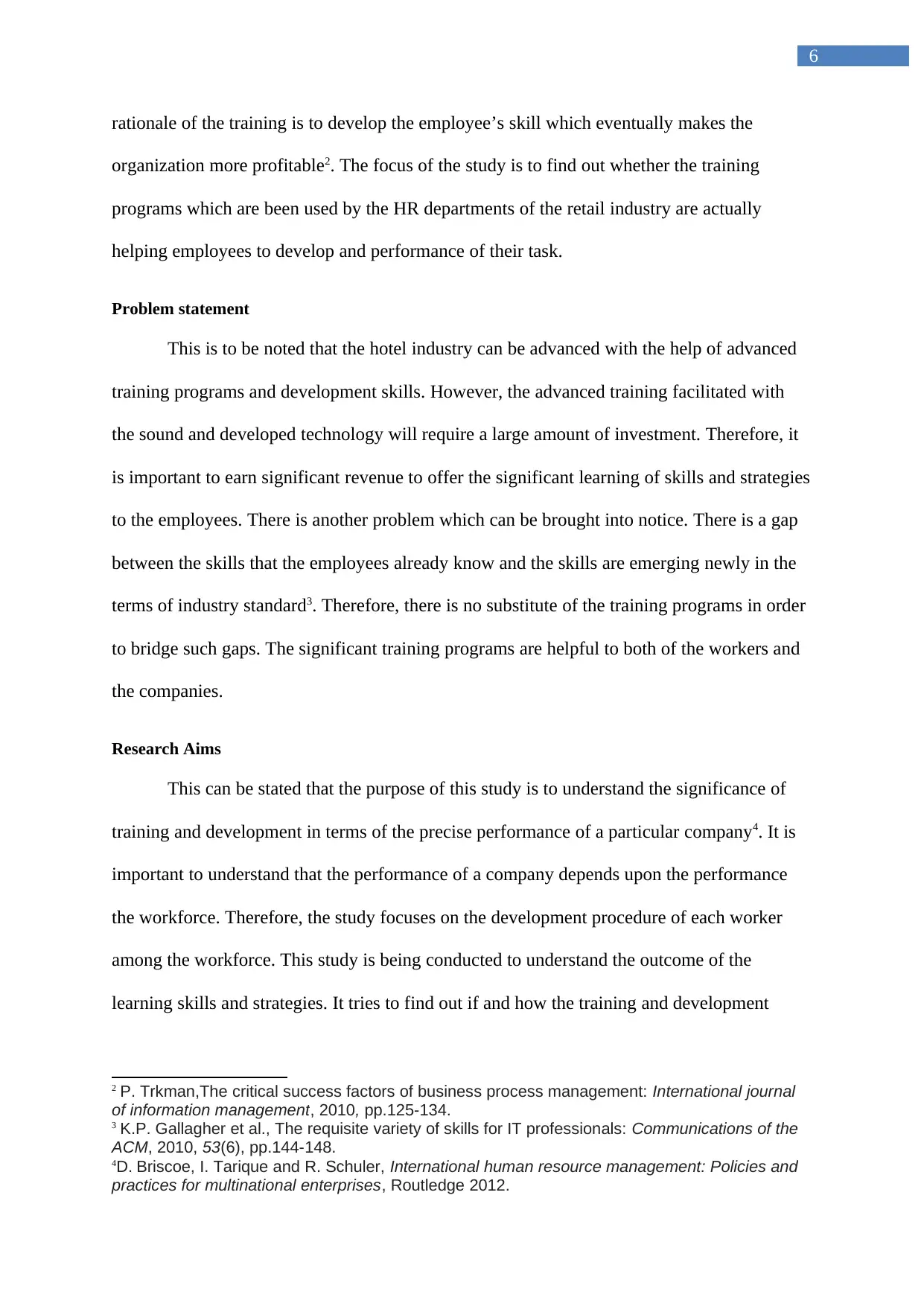
6
rationale of the training is to develop the employee’s skill which eventually makes the
organization more profitable2. The focus of the study is to find out whether the training
programs which are been used by the HR departments of the retail industry are actually
helping employees to develop and performance of their task.
Problem statement
This is to be noted that the hotel industry can be advanced with the help of advanced
training programs and development skills. However, the advanced training facilitated with
the sound and developed technology will require a large amount of investment. Therefore, it
is important to earn significant revenue to offer the significant learning of skills and strategies
to the employees. There is another problem which can be brought into notice. There is a gap
between the skills that the employees already know and the skills are emerging newly in the
terms of industry standard3. Therefore, there is no substitute of the training programs in order
to bridge such gaps. The significant training programs are helpful to both of the workers and
the companies.
Research Aims
This can be stated that the purpose of this study is to understand the significance of
training and development in terms of the precise performance of a particular company4. It is
important to understand that the performance of a company depends upon the performance
the workforce. Therefore, the study focuses on the development procedure of each worker
among the workforce. This study is being conducted to understand the outcome of the
learning skills and strategies. It tries to find out if and how the training and development
2 P. Trkman,The critical success factors of business process management: International journal
of information management, 2010, pp.125-134.
3 K.P. Gallagher et al., The requisite variety of skills for IT professionals: Communications of the
ACM, 2010, 53(6), pp.144-148.
4D. Briscoe, I. Tarique and R. Schuler, International human resource management: Policies and
practices for multinational enterprises, Routledge 2012.
rationale of the training is to develop the employee’s skill which eventually makes the
organization more profitable2. The focus of the study is to find out whether the training
programs which are been used by the HR departments of the retail industry are actually
helping employees to develop and performance of their task.
Problem statement
This is to be noted that the hotel industry can be advanced with the help of advanced
training programs and development skills. However, the advanced training facilitated with
the sound and developed technology will require a large amount of investment. Therefore, it
is important to earn significant revenue to offer the significant learning of skills and strategies
to the employees. There is another problem which can be brought into notice. There is a gap
between the skills that the employees already know and the skills are emerging newly in the
terms of industry standard3. Therefore, there is no substitute of the training programs in order
to bridge such gaps. The significant training programs are helpful to both of the workers and
the companies.
Research Aims
This can be stated that the purpose of this study is to understand the significance of
training and development in terms of the precise performance of a particular company4. It is
important to understand that the performance of a company depends upon the performance
the workforce. Therefore, the study focuses on the development procedure of each worker
among the workforce. This study is being conducted to understand the outcome of the
learning skills and strategies. It tries to find out if and how the training and development
2 P. Trkman,The critical success factors of business process management: International journal
of information management, 2010, pp.125-134.
3 K.P. Gallagher et al., The requisite variety of skills for IT professionals: Communications of the
ACM, 2010, 53(6), pp.144-148.
4D. Briscoe, I. Tarique and R. Schuler, International human resource management: Policies and
practices for multinational enterprises, Routledge 2012.
Paraphrase This Document
Need a fresh take? Get an instant paraphrase of this document with our AI Paraphraser
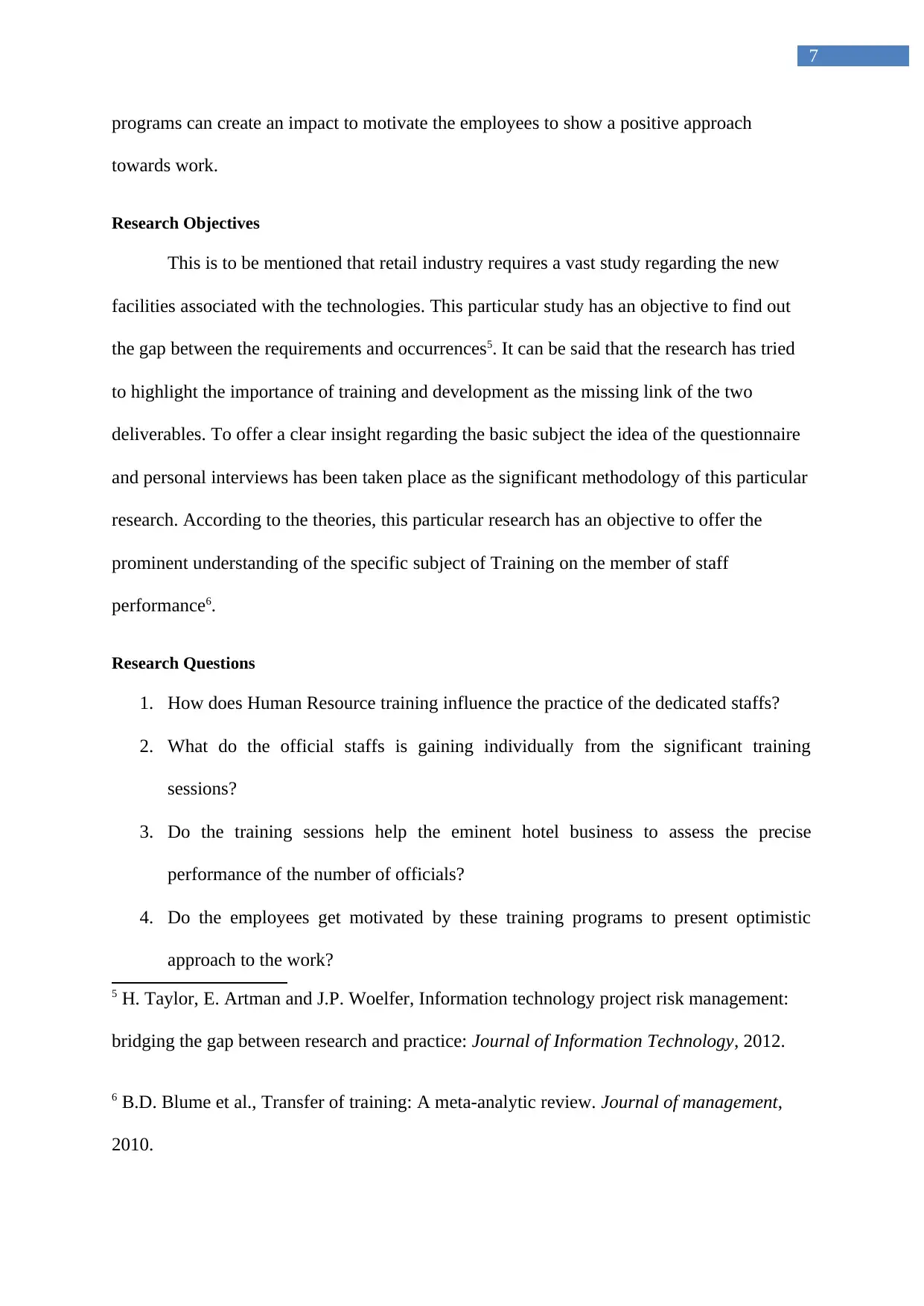
7
programs can create an impact to motivate the employees to show a positive approach
towards work.
Research Objectives
This is to be mentioned that retail industry requires a vast study regarding the new
facilities associated with the technologies. This particular study has an objective to find out
the gap between the requirements and occurrences5. It can be said that the research has tried
to highlight the importance of training and development as the missing link of the two
deliverables. To offer a clear insight regarding the basic subject the idea of the questionnaire
and personal interviews has been taken place as the significant methodology of this particular
research. According to the theories, this particular research has an objective to offer the
prominent understanding of the specific subject of Training on the member of staff
performance6.
Research Questions
1. How does Human Resource training influence the practice of the dedicated staffs?
2. What do the official staffs is gaining individually from the significant training
sessions?
3. Do the training sessions help the eminent hotel business to assess the precise
performance of the number of officials?
4. Do the employees get motivated by these training programs to present optimistic
approach to the work?
5 H. Taylor, E. Artman and J.P. Woelfer, Information technology project risk management:
bridging the gap between research and practice: Journal of Information Technology, 2012.
6 B.D. Blume et al., Transfer of training: A meta-analytic review. Journal of management,
2010.
programs can create an impact to motivate the employees to show a positive approach
towards work.
Research Objectives
This is to be mentioned that retail industry requires a vast study regarding the new
facilities associated with the technologies. This particular study has an objective to find out
the gap between the requirements and occurrences5. It can be said that the research has tried
to highlight the importance of training and development as the missing link of the two
deliverables. To offer a clear insight regarding the basic subject the idea of the questionnaire
and personal interviews has been taken place as the significant methodology of this particular
research. According to the theories, this particular research has an objective to offer the
prominent understanding of the specific subject of Training on the member of staff
performance6.
Research Questions
1. How does Human Resource training influence the practice of the dedicated staffs?
2. What do the official staffs is gaining individually from the significant training
sessions?
3. Do the training sessions help the eminent hotel business to assess the precise
performance of the number of officials?
4. Do the employees get motivated by these training programs to present optimistic
approach to the work?
5 H. Taylor, E. Artman and J.P. Woelfer, Information technology project risk management:
bridging the gap between research and practice: Journal of Information Technology, 2012.
6 B.D. Blume et al., Transfer of training: A meta-analytic review. Journal of management,
2010.
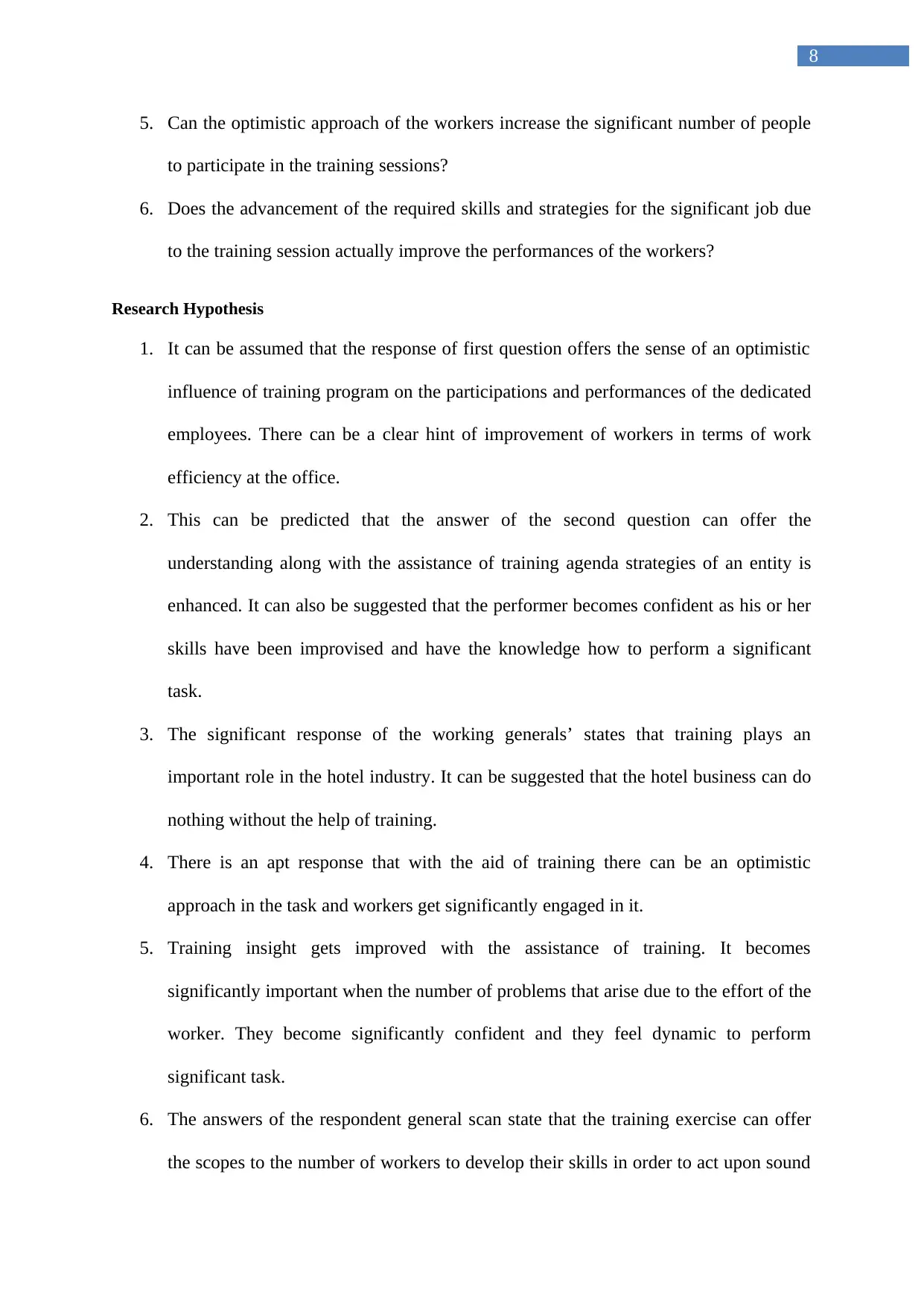
8
5. Can the optimistic approach of the workers increase the significant number of people
to participate in the training sessions?
6. Does the advancement of the required skills and strategies for the significant job due
to the training session actually improve the performances of the workers?
Research Hypothesis
1. It can be assumed that the response of first question offers the sense of an optimistic
influence of training program on the participations and performances of the dedicated
employees. There can be a clear hint of improvement of workers in terms of work
efficiency at the office.
2. This can be predicted that the answer of the second question can offer the
understanding along with the assistance of training agenda strategies of an entity is
enhanced. It can also be suggested that the performer becomes confident as his or her
skills have been improvised and have the knowledge how to perform a significant
task.
3. The significant response of the working generals’ states that training plays an
important role in the hotel industry. It can be suggested that the hotel business can do
nothing without the help of training.
4. There is an apt response that with the aid of training there can be an optimistic
approach in the task and workers get significantly engaged in it.
5. Training insight gets improved with the assistance of training. It becomes
significantly important when the number of problems that arise due to the effort of the
worker. They become significantly confident and they feel dynamic to perform
significant task.
6. The answers of the respondent general scan state that the training exercise can offer
the scopes to the number of workers to develop their skills in order to act upon sound
5. Can the optimistic approach of the workers increase the significant number of people
to participate in the training sessions?
6. Does the advancement of the required skills and strategies for the significant job due
to the training session actually improve the performances of the workers?
Research Hypothesis
1. It can be assumed that the response of first question offers the sense of an optimistic
influence of training program on the participations and performances of the dedicated
employees. There can be a clear hint of improvement of workers in terms of work
efficiency at the office.
2. This can be predicted that the answer of the second question can offer the
understanding along with the assistance of training agenda strategies of an entity is
enhanced. It can also be suggested that the performer becomes confident as his or her
skills have been improvised and have the knowledge how to perform a significant
task.
3. The significant response of the working generals’ states that training plays an
important role in the hotel industry. It can be suggested that the hotel business can do
nothing without the help of training.
4. There is an apt response that with the aid of training there can be an optimistic
approach in the task and workers get significantly engaged in it.
5. Training insight gets improved with the assistance of training. It becomes
significantly important when the number of problems that arise due to the effort of the
worker. They become significantly confident and they feel dynamic to perform
significant task.
6. The answers of the respondent general scan state that the training exercise can offer
the scopes to the number of workers to develop their skills in order to act upon sound
⊘ This is a preview!⊘
Do you want full access?
Subscribe today to unlock all pages.

Trusted by 1+ million students worldwide
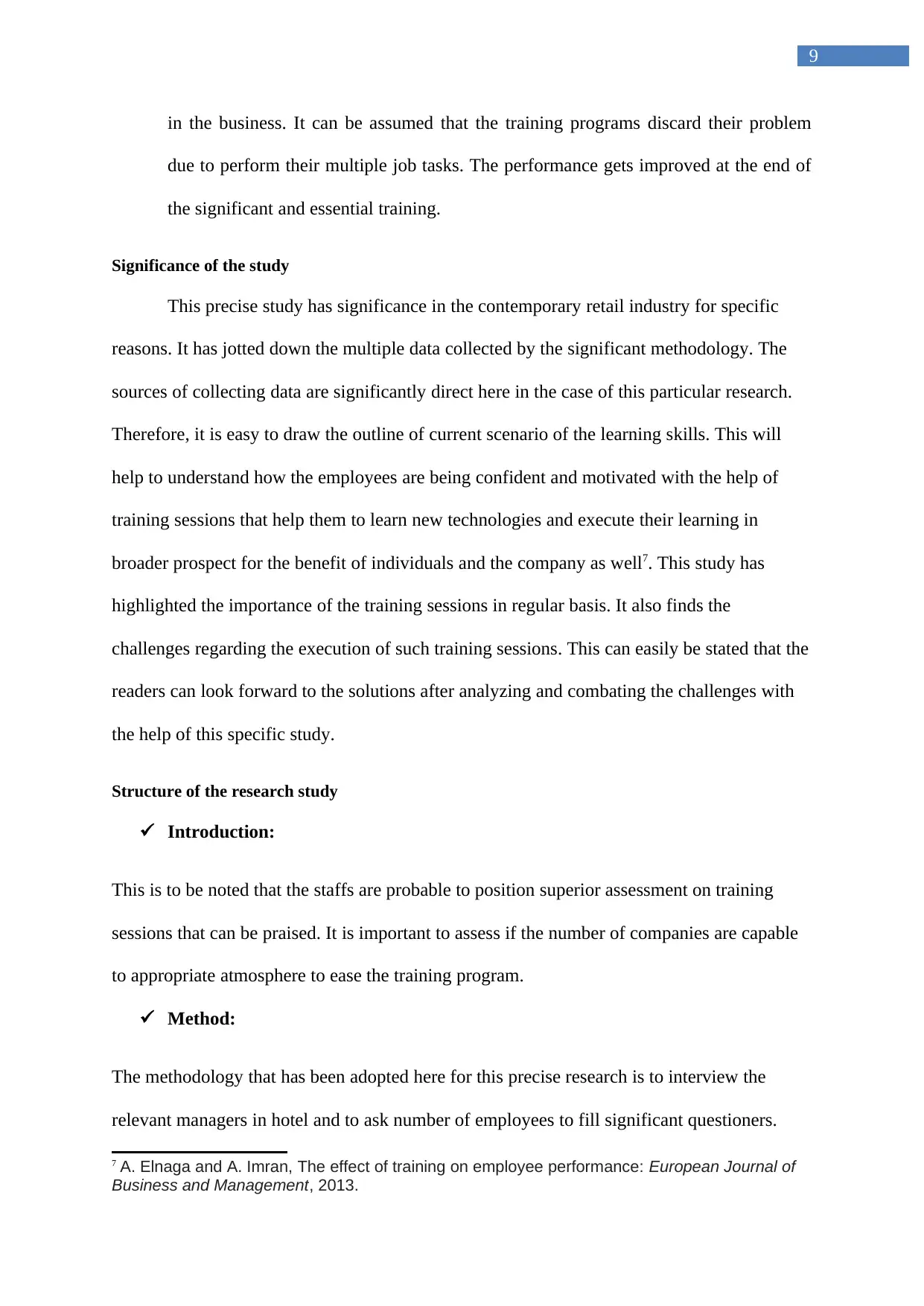
9
in the business. It can be assumed that the training programs discard their problem
due to perform their multiple job tasks. The performance gets improved at the end of
the significant and essential training.
Significance of the study
This precise study has significance in the contemporary retail industry for specific
reasons. It has jotted down the multiple data collected by the significant methodology. The
sources of collecting data are significantly direct here in the case of this particular research.
Therefore, it is easy to draw the outline of current scenario of the learning skills. This will
help to understand how the employees are being confident and motivated with the help of
training sessions that help them to learn new technologies and execute their learning in
broader prospect for the benefit of individuals and the company as well7. This study has
highlighted the importance of the training sessions in regular basis. It also finds the
challenges regarding the execution of such training sessions. This can easily be stated that the
readers can look forward to the solutions after analyzing and combating the challenges with
the help of this specific study.
Structure of the research study
Introduction:
This is to be noted that the staffs are probable to position superior assessment on training
sessions that can be praised. It is important to assess if the number of companies are capable
to appropriate atmosphere to ease the training program.
Method:
The methodology that has been adopted here for this precise research is to interview the
relevant managers in hotel and to ask number of employees to fill significant questioners.
7 A. Elnaga and A. Imran, The effect of training on employee performance: European Journal of
Business and Management, 2013.
in the business. It can be assumed that the training programs discard their problem
due to perform their multiple job tasks. The performance gets improved at the end of
the significant and essential training.
Significance of the study
This precise study has significance in the contemporary retail industry for specific
reasons. It has jotted down the multiple data collected by the significant methodology. The
sources of collecting data are significantly direct here in the case of this particular research.
Therefore, it is easy to draw the outline of current scenario of the learning skills. This will
help to understand how the employees are being confident and motivated with the help of
training sessions that help them to learn new technologies and execute their learning in
broader prospect for the benefit of individuals and the company as well7. This study has
highlighted the importance of the training sessions in regular basis. It also finds the
challenges regarding the execution of such training sessions. This can easily be stated that the
readers can look forward to the solutions after analyzing and combating the challenges with
the help of this specific study.
Structure of the research study
Introduction:
This is to be noted that the staffs are probable to position superior assessment on training
sessions that can be praised. It is important to assess if the number of companies are capable
to appropriate atmosphere to ease the training program.
Method:
The methodology that has been adopted here for this precise research is to interview the
relevant managers in hotel and to ask number of employees to fill significant questioners.
7 A. Elnaga and A. Imran, The effect of training on employee performance: European Journal of
Business and Management, 2013.
Paraphrase This Document
Need a fresh take? Get an instant paraphrase of this document with our AI Paraphraser

10
Result:
This can easily be stated after applying this methodology that the training program and
employee performance share a powerful bond8. It has also be found out that the both the
Lahore managers and workers express their interest in improving their skill by organizing
such programs and learning from it.
Discussion:
This is notable that 75%respondents in this significant study suggested that training sessions
ease the improvement of performance of the staffs9. It can be said that basic requirement of
the training session is been observed by the performance evaluation.
Conclusion:
It is evident from this precise study that the training programs have straight impact on
the performances of the staffs. These programs have a significance to raise the degree of the
entire performance of the workers. These programs advance the competence of workforce as
progress level presentation. This is notable that study findings are clearly indicating the
genuine performance of a particular staff can be influenced by the training programs.
Therefore, the association between the two variables like Training & Employee Performance
is optimistic. The research is been done in the retail industry of United Kingdom where it can
clearly be observed that training plays an important role in industry.
8 K. Jehanzeb and N.A. Bashir, Training and development program and its benefits to
employee and organization: A conceptual study: European Journal of business and
management, 2013.
9 A. Brightwell and J. Grant, Competency-based training: who benefits: Postgraduate
medical journal, 2013.
Result:
This can easily be stated after applying this methodology that the training program and
employee performance share a powerful bond8. It has also be found out that the both the
Lahore managers and workers express their interest in improving their skill by organizing
such programs and learning from it.
Discussion:
This is notable that 75%respondents in this significant study suggested that training sessions
ease the improvement of performance of the staffs9. It can be said that basic requirement of
the training session is been observed by the performance evaluation.
Conclusion:
It is evident from this precise study that the training programs have straight impact on
the performances of the staffs. These programs have a significance to raise the degree of the
entire performance of the workers. These programs advance the competence of workforce as
progress level presentation. This is notable that study findings are clearly indicating the
genuine performance of a particular staff can be influenced by the training programs.
Therefore, the association between the two variables like Training & Employee Performance
is optimistic. The research is been done in the retail industry of United Kingdom where it can
clearly be observed that training plays an important role in industry.
8 K. Jehanzeb and N.A. Bashir, Training and development program and its benefits to
employee and organization: A conceptual study: European Journal of business and
management, 2013.
9 A. Brightwell and J. Grant, Competency-based training: who benefits: Postgraduate
medical journal, 2013.

11
⊘ This is a preview!⊘
Do you want full access?
Subscribe today to unlock all pages.

Trusted by 1+ million students worldwide
1 out of 50
Related Documents
Your All-in-One AI-Powered Toolkit for Academic Success.
+13062052269
info@desklib.com
Available 24*7 on WhatsApp / Email
![[object Object]](/_next/static/media/star-bottom.7253800d.svg)
Unlock your academic potential
Copyright © 2020–2025 A2Z Services. All Rights Reserved. Developed and managed by ZUCOL.





